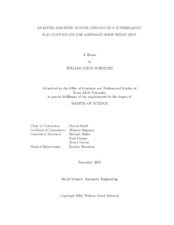| dc.contributor.advisor | Hartl, Darren | |
| dc.contributor.advisor | Strganac, Thomas | |
| dc.creator | Scholten, William David | |
| dc.date.accessioned | 2017-03-02T16:49:56Z | |
| dc.date.available | 2018-12-01T07:20:07Z | |
| dc.date.created | 2016-12 | |
| dc.date.issued | 2016-11-18 | |
| dc.date.submitted | December 2016 | |
| dc.identifier.uri | https://hdl.handle.net/1969.1/159068 | |
| dc.description.abstract | During low speed maneuvers, such as landing and approach, a significant portion of the noise generated by transport aircraft is due to airframe noise. The leading-edge slat is a primary source of airframe noise. Previous work has shown that the slat-cove filler (SCF) is effective at mitigating the noise generated by the slat. The objective of this work was to further the development of a superelastic shape memory alloy (SMA) SCF concept by investigating fluid-structure interaction (FSI) behavior via computational and physical models.
Structural optimization of a SCF design for a representative, transport-class airfoil was first conducted considering the SCF response to aerodynamic and slat retraction loads. The objective of the optimization was to minimize the actuation force needed to retract the slat and SCF. A monolithic SMA SCF was found to minimize the actuation force while satisfying constraints, which agreed with findings from prototype testing on the bench-top apparatus.
The success of the design optimization motivated further work that sought to determine how the SCF responded in flow using a combination of finite volume fluid models and finite element structural models based on a small-scale wind tunnel model of a conventional multi-element wing configuration with a SCF. Multiple angles of attack and deployment states of high lift devices were considered for computational fluid dynamics (CFD) analysis to gain an initial understanding of the flow around the wing. FSI analysis of the SCF in flow was conducted for multiple load cases using a framework that was compatible with custom material subroutines (for SMA material response). Wind tunnel testing of a physical model of the multi-element wing configuration was used to begin validation of the CFD and FSI models. | en |
| dc.format.mimetype | application/pdf | |
| dc.language.iso | en | |
| dc.subject | SMA | en |
| dc.subject | FSI | en |
| dc.subject | CFD | en |
| dc.subject | Wind Tunnel | en |
| dc.title | Analysis and Wind Tunnel Testing of a Superelastic Slat-Cove Filler for Airframe Noise Reduction | en |
| dc.type | Thesis | en |
| thesis.degree.department | Aerospace Engineering | en |
| thesis.degree.discipline | Aerospace Engineering | en |
| thesis.degree.grantor | Texas A & M University | en |
| thesis.degree.name | Master of Science | en |
| thesis.degree.level | Masters | en |
| dc.contributor.committeeMember | Malak, Richard | |
| dc.contributor.committeeMember | Cizmas, Paul | |
| dc.contributor.committeeMember | Turner, Travis | |
| dc.type.material | text | en |
| dc.date.updated | 2017-03-02T16:49:56Z | |
| local.embargo.terms | 2018-12-01 | |
| local.etdauthor.orcid | 0000-0001-6373-6857 | |


